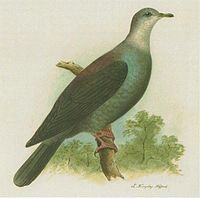- Bonin Wood Pigeon
-
Bonin Wood Pigeon 
Conservation status Scientific classification Kingdom: Animalia Phylum: Chordata Class: Aves Order: Columbiformes Family: Columbidae Genus: Columba Species: C. versicolor Binomial name Columba versicolor
Kittlitz, 1832The Bonin Wood Pigeon (Columba versicolor) was a pigeon endemic to Nakodo-jima ("Nakondo" is a frequent spelling error) and Chichi-jima in the Ogasawara Islands off the coast of Japan. It is known from four recorded specimens, the first from 1827 and the last from 1889. They averaged a length of 45 cm. This pigeon died out late in the 19th century as a result of deforestation, hunting, and predation by introduced rats and cats.
Contents
Description
The Bonin Wood Pigeon was a medium-sized pigeon, with an average length of 45 cm. The upper parts of the Pigeon's body were greyish-black with iridescence except on wing and tail. Crown has a green-purple iridescence, mantle to rump iridescent reflecting violet, amethyst and turquoise. Scapulars and remaining mantle glossed golden green with bronze reflections; wing coverts with dark turquoise green suffused with deep blue. The uppertail of the pigeon coverts broadly tipped with golden green. Breast to belly fringed with deep green and violet iridescence, being strongest on the breast. Iris blue or probably dark blue; bill greenish yellow having a pale tip; legs and the feet were dark red.
Last confirmed sighting
The Bonin Wood Pigeon was confirmed extinct in Spring 1889 and the last sighting was in the forests of the Nakodo-Jima, Japan.
Reproduction
The Bonin Wood Pigeons usually mated in the trees or in the forests. Their eggs were particularly vulnerable to Crows and other natural predators. They each normally make two eggs and the pigeons eggs usually takes 17 to 19 days to hatch into a young Bonin Wood Pigeon, just like any other Wood Pigeons of today.
References
- BirdLife International (2004). Columba versicolor. 2006. IUCN Red List of Threatened Species. IUCN 2006. www.iucnredlist.org. Retrieved on 10 May 2006. Database entry includes justification for why this species is listed as extinct
- Kittlitz, Heinrich von (1832): Kupfertafeln zur Naturgeschichte der Vögel 1: 5, plate V/2. Frankfurt.
External links

This Columbiformes-related article is a stub. You can help Wikipedia by expanding it.

